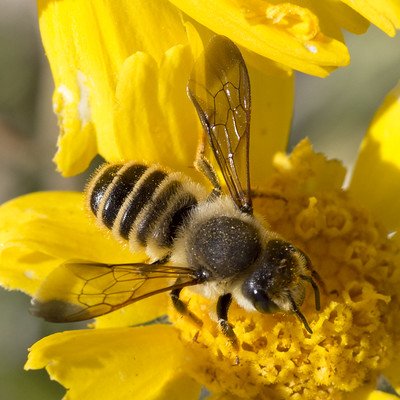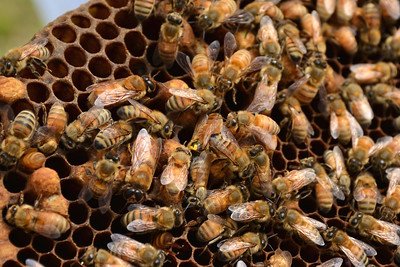Bee Responsible; Protect Our Pollinators
Pollinators need our protection. Did you know that pollinators such as Bees and Butterflies are needed for 90% of the reproduction of flowering plants on earth and 1/3 of human food crops? 1/3!!!
All of our favorite fruits and vegetables would not be possible without our precious pollinators... just think if there were no Mangoes, Lychee's, Papayas, Cucumbers, or Tomatoes?! What a tasteless world we would live in.
Earths biological diversity along with our quality of life and the wide range of foods we eat depend on these tiny but mighty creatures. Our future depends on us cohabiting the earth together.
In short, the future needs to be filled with pollinators.
Gulf Fritillary Butterfly
"Flowering plants across wild, farmed and even urban landscapes actually feed the terrestrial world, and pollinators are the great connectors who enable this giant food system to work for all who eat… including us. "
-- Roger Lang,
Chairman, Pollinator partnership
Meet Your Pacific Pollinators
These are just a few of the most common pollinators you'll see buzzing around Hawai'i; Bees, Hover Flies, and Butterflies. Hawai'i does have a native bee, the solitary yellow-faced bee, but most of the bees you see were introduced to Hawai'i way back in 1857. The native bee does not make honey but is a treasured pollinator nonetheless. Among the most common are the European honeybee (Apis mellifera), the much larger, heavier, (and in my opinion cuter) carpenter bee, and several species of leaf cutter bees.
Hylaeus longiceps, also known as the longhead yellow-faced bee, is a species of bee endemic to Hawai'i
Leaf cutter bees are really special. They look like average Honey Bees but collect their pollen on hairs under their abdomen instead of their hind legs. Plus they like to make perfect little cut out circles in leaves!
Hover flies are bright and shiny and have a body made of metallic colors. They are the hero's of our beloved fruit trees such as mangoes and cocoa.
Butterflies will flutter through your garden no doubt, but to encourage them to stay and reproduce, it is necessary to plant larval food for their young. Plants that their caterpillar babies can eat and grow big on.
We also have Bats, Moths, and Beetles that help to pollinate plants here in Hawai'i. They are highly valued in the pollinator ecosystem. Treasured natives like Naupaka and Maile require some of these elusive pollinators.
Pollinators in Peril
Recently gardeners on Oahu and the Big Island of Hawaii have been worried about the sudden decline in honeybees and insect pollinators. The low numbers of honeybees in some areas is primarily due to the arrival of new honeybee pests and an increase in viral diseases.
Enter the Varroa mite... This parasitic mite arrived to the Islands in 2007 and is considered one of the most devastating pests of honeybees. It not only feeds on their blood but it also transmits a deadly viral disease, called Deformed Wing Virus, to the colonies.
The "double whammy" combo of the mite and virus are believed to be involved in large colony losses all over the world!
Additionally, since 2010 our Hawaiian bees are also facing the small hive beetle, a pest that feeds on hive materials (pollen and honey) as well as on developing bees.
Local beekeepers have lost a large number of hives due to the new pests, but the managed colonies are slowly starting to
make a comeback. In fact, the bees seen foraging on the local gardens are most likely workers bees from a nearby apiary.
Take courage, not all hope is lost... We sat down with local bee keepers, Melissa and Jackson Nash. We believe there is no better way to get to know the Bee's than through a local Bee Keeper. Melissa and Jackson have 10 years experience farming on Kaua'i and recently began hosting school groups and tourists to give them an authentic beekeeping experience.
Please pay attention to their words of wisdom so you can have an active part in protecting our Pacific Pollinators.
Meet Melissa & Jackson Nash, Project Directors at Stellar Gardens, Kaua'i, HI
Give a brief description of your farm and your hives. What is your vision and intentions with Bee Keeping?
"Stellar Gardens is a family of artists exploring sustainability. For ten years, we have been growing our family while learning to grow food, tend bees and operate with a smaller footprint on our planet.Our favorite part of having bees is sharing our love for them with others.
In addition to our hives at Stellar Gardens, we have hives at a friend’s house and tend those bees alongside their children and ours.
This year we began hosting school groups and tourists for beekeeping experiences. It’s been especially fun and fulfilling to share with the keiki!
Longer term, we would like to establish a world class apiary and teaching center. "
Why do you love bees?
"We love bees because they’re so sweet and fuzzy and cute! And also because bees are some of the most complex and intriguing creatures. They’re mysterious. There’s so much we don’t know about them and we can learn so much about ourselves by studying them. Their existence is gravely threatened by the way humans are choosing to live. By choosing to live differently we hope to inspire others to make loving choices that support honey bees and all the pollinators."
"Do you live in place where you can plant flowers, flowering trees, or have hives? Are you able to move to a place where you can? Every little bit helps. Without pollinators, we no longer have a natural food supply. So we have taken real life practical action, as we wish to create a future rich in abundance of clean food and delicious honey."
Have you noticed any challenges the bees might be facing?
"Here on the north-east shore, we are fortunate to have so many nourishing flowers for the bees. Thankfully, right now our hives seem really happy and don’t seem to suffer from much of anything lately. In the past we’ve had issues with hive beetles, wax moths and toads!"
"Right now, I think the biggest threat to bees on Kauai is pesticides. I believe the use of all pesticides should be completely stopped by our citizens and county. There are so many better and more creative and engaging alternatives. One being planting pollinator friendly low plants along the highways instead of spraying the guinea grass with glyphosate, which harms everything around it, including the humans spraying it."
Have you noticed anything that helps the pollinators?
"Organic. Organic. Organic. Supporting organic wherever and however one can is globally import. We have to vote with our dollars and supporting organics will push the corporations to change which will make it more affordable too. More organic, less pesticides."
"The more flowers and flowering trees we plant, the happier our bees seem. Flowers and flowering trees are always helpful and beautiful. Our bees absolutely love our Tulsi Basil bushes. I always plant it where I spend the most time so I can spend lots of time observing the bees while they forage for nectar. Tulsi also makes a rich orange pollen that I love to see on the bees."
What would you like people to know about our pacific pollinators in moving forward and taking care of them and in doing so, ourselves.
"We want people to understand how wonderful they are and how lucky it is to have them on our island. We have to support them. Kaua’i is one of the last refuges for truly happy healthy honeybees and we have to do everything we can to keep it that way."
*if you'd like to keep up with the buzz Melissa and Jackson got going on you can contact them at stellargardenskauai@gmail.com or on Instagram.
What can we do to help?
Like Melissa and Jackson said, it is vital that we take immediate steps to help pollinator populations thrive. In doing so we support our own needs for food and support diversity and beauty in the natural world. Every action we take has a direct consequence in the world around us. What we do affects everything else. So lets's help the pollinators!
A good place to start...
Add plants to your landscape that provide food and shelter for pollinators (more on that below).
Manage or eliminate the use of pesticides to reduce the impact on native pollinators.
Minimize tillage to protect ground nesting pollinators.
Spare some dead branches as nesting sites for solitary bees.
Ensure water sources are scattered throughout the landscape (pollinators get thirsty!).
Use a variety of plants, rather than a single type to ensure blooms year round.
Plant the same species in clumps. The larger the display, the more attractive the patch.
Plants For Pollinators
Honestly if we tried to list all the different plants that you can plant in your home garden to help the pollinators, this blog post would turn into a book! It's a good thing that someone has already done this.
“If the bee disappeared off the surface of the globe, then man would have only four years of life left. No more bees, no more pollination, no more plants, no more animals, no more man.”
― Albert Einstein
Below is a chart put together by the North American Pollinator Protection Campaign (NAPPC) of local and native plants and their matching pollinator counterpart. They have put together an extensive review and article about which plants and pollinators you can put in your home garden.
I encourage you to check it out!
Plant these to create a Pollinator Garden
Here is a list of plants you can find at Seascapes Nursery that bees love! - pick some up today and protect our pollinators!
Agapanthus
Angel’s Trumpet
Basil
Begonias
Blue Daze
Bottle Brush Tree
Bush Allamanda
Caesalpinia
Cat Whiskers
Cestrum
Coleus
Cup and Saucer Shrub
Cigarbush
Clerodendrum species
Crownflower
Duranta
Mexican Heather
Lavender
Mickey Mouse Plant
Palms
Panama Rose
Pentas
Puffball Trees
Rose
Salvia
Society Garlic
Surinam Cherry
Pollinator Plant Giveaway!
Purple Salvia with Butterfly
In honor of our pollinators, Seascapes Nursery is giving way a FREE PLANT aimed to help you attract more pollinators into your garden. 5 lucky people will win a 1 gallon Salvia plant! Sign up to our newsletter and enter to win here.
"The more flowers and flowering trees we plant, the happier our bees." - Melissa Nash
Without pollinators, we no longer have a natural food supply. Do you take that seriously? Protect our Hawaiian Pollinators and do what you can to minimize pesticides, create a conducive habitat, and of course plant more flowers!
If you enjoyed this article please share with your loved ones and spread the word! Come into Seascapes and we will help you get your pollinator garden started. We offer customized garden designs and pollinator friendly plants in every color!
Bee well - ALOHA!
Resources:


















